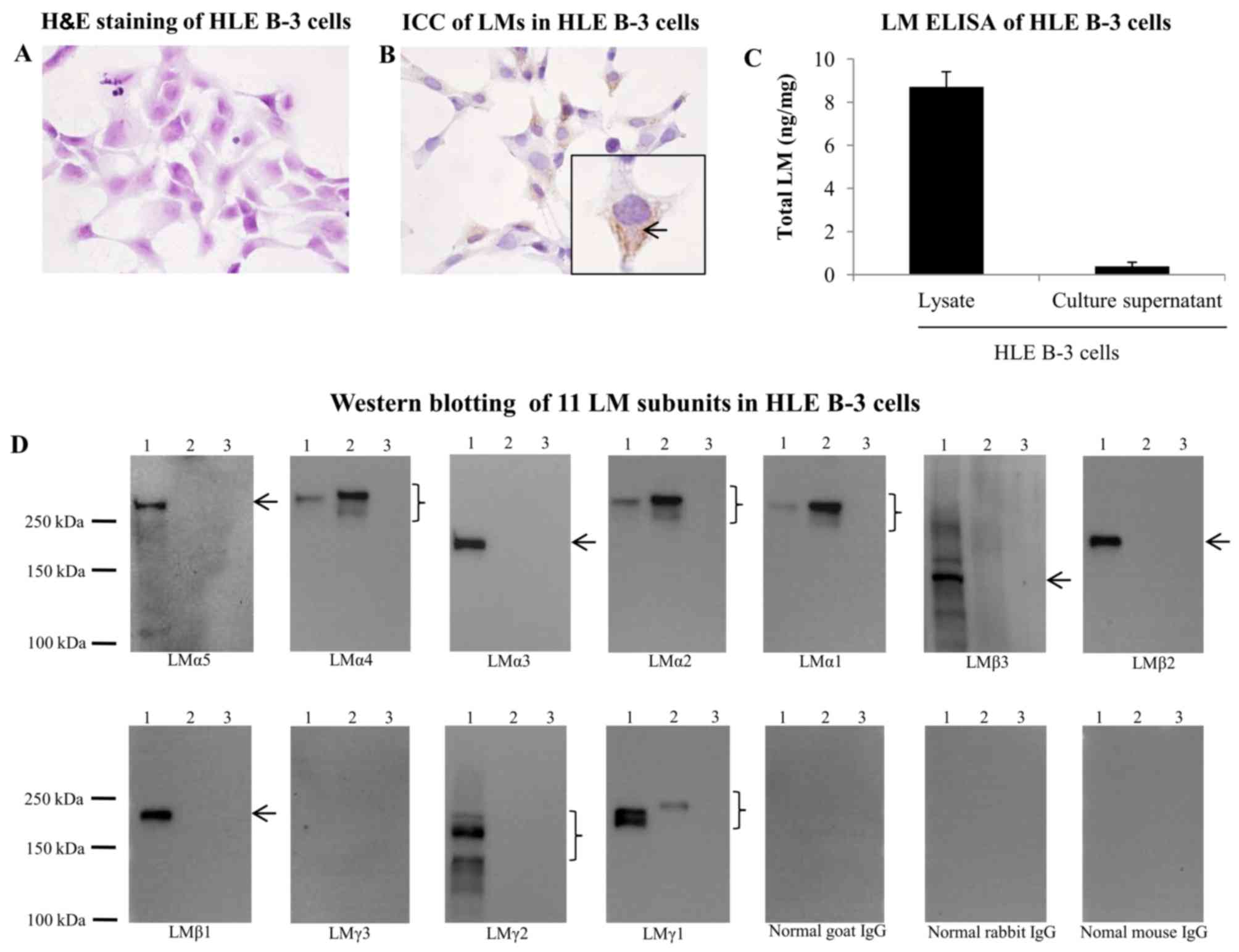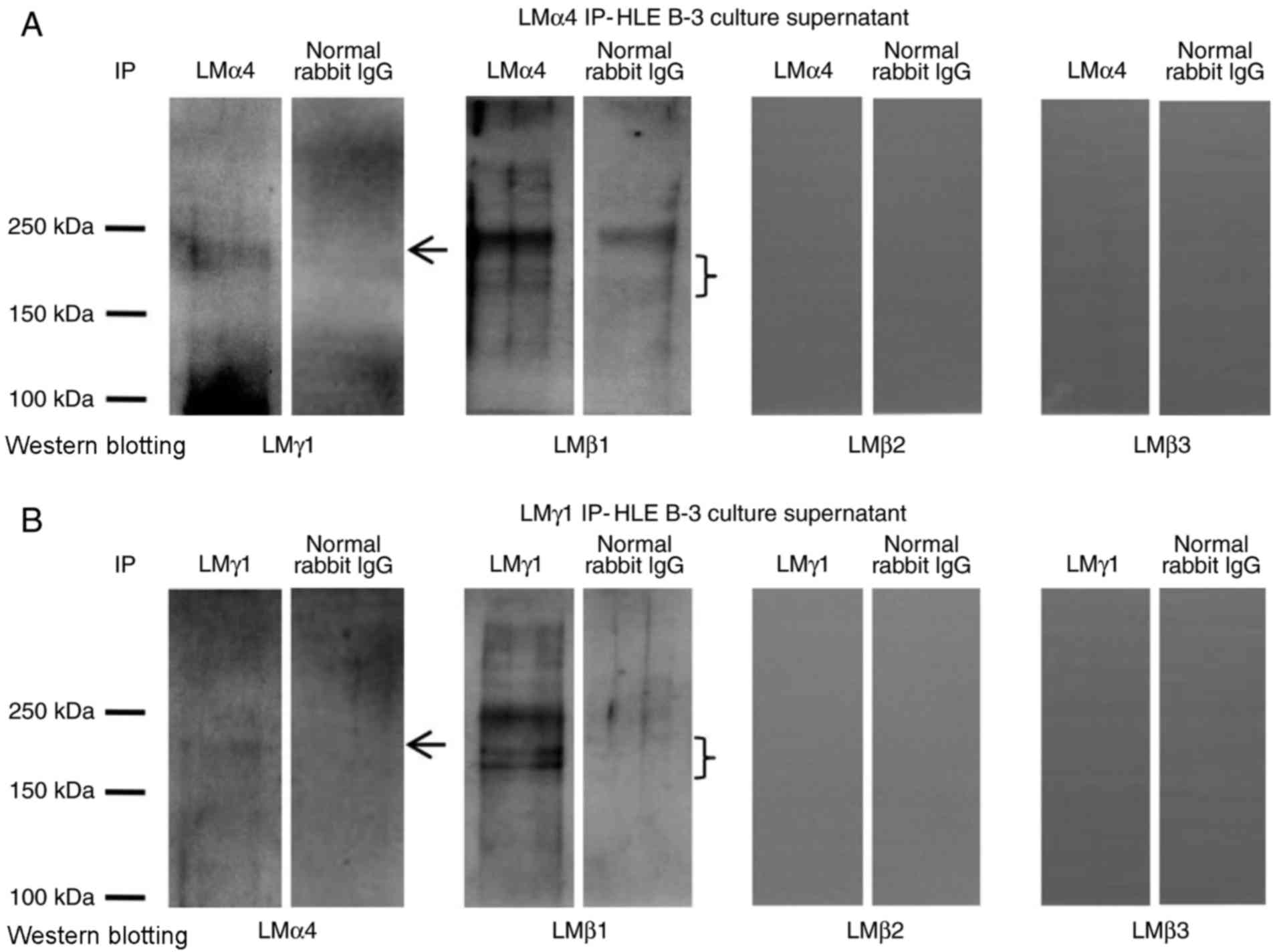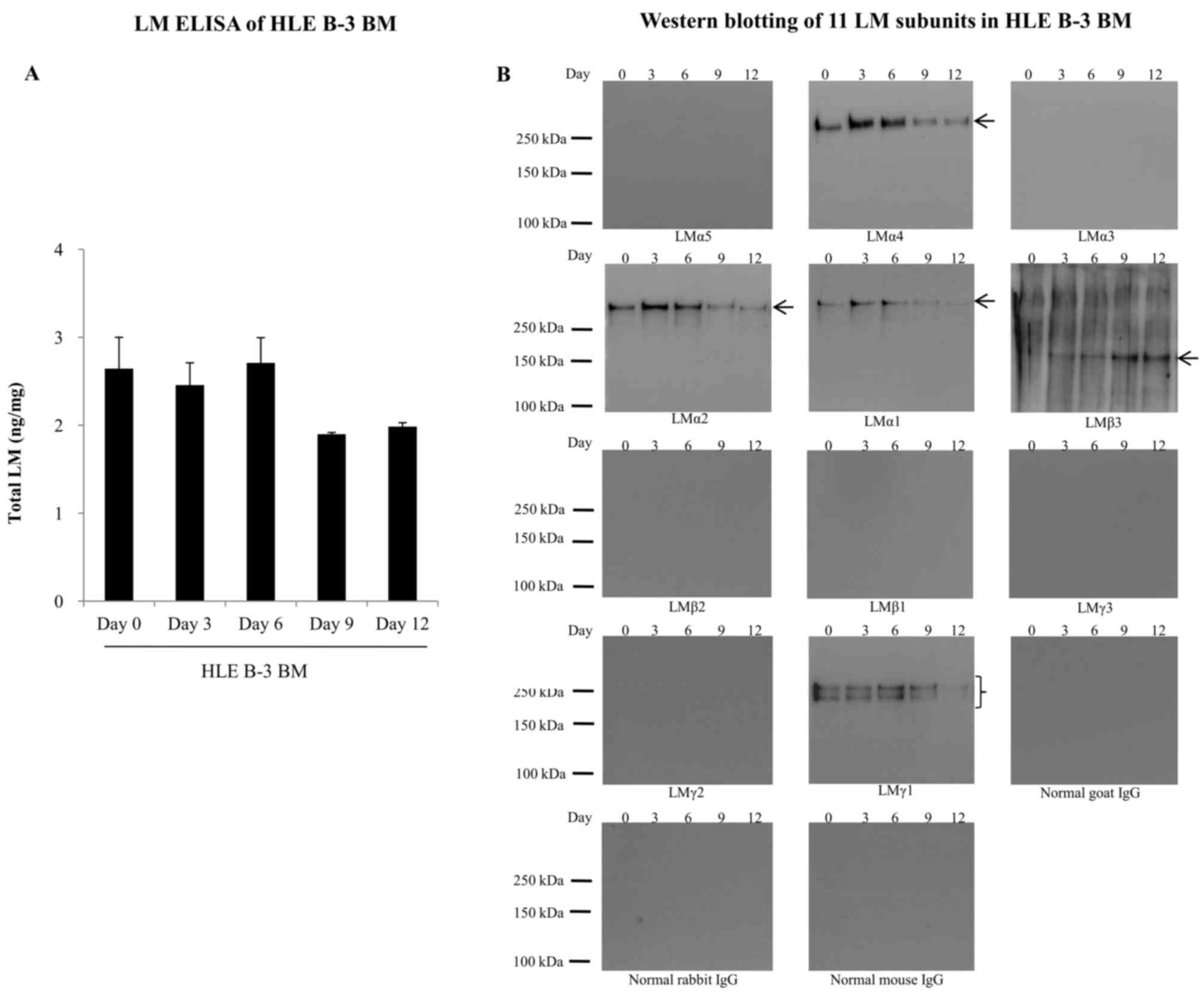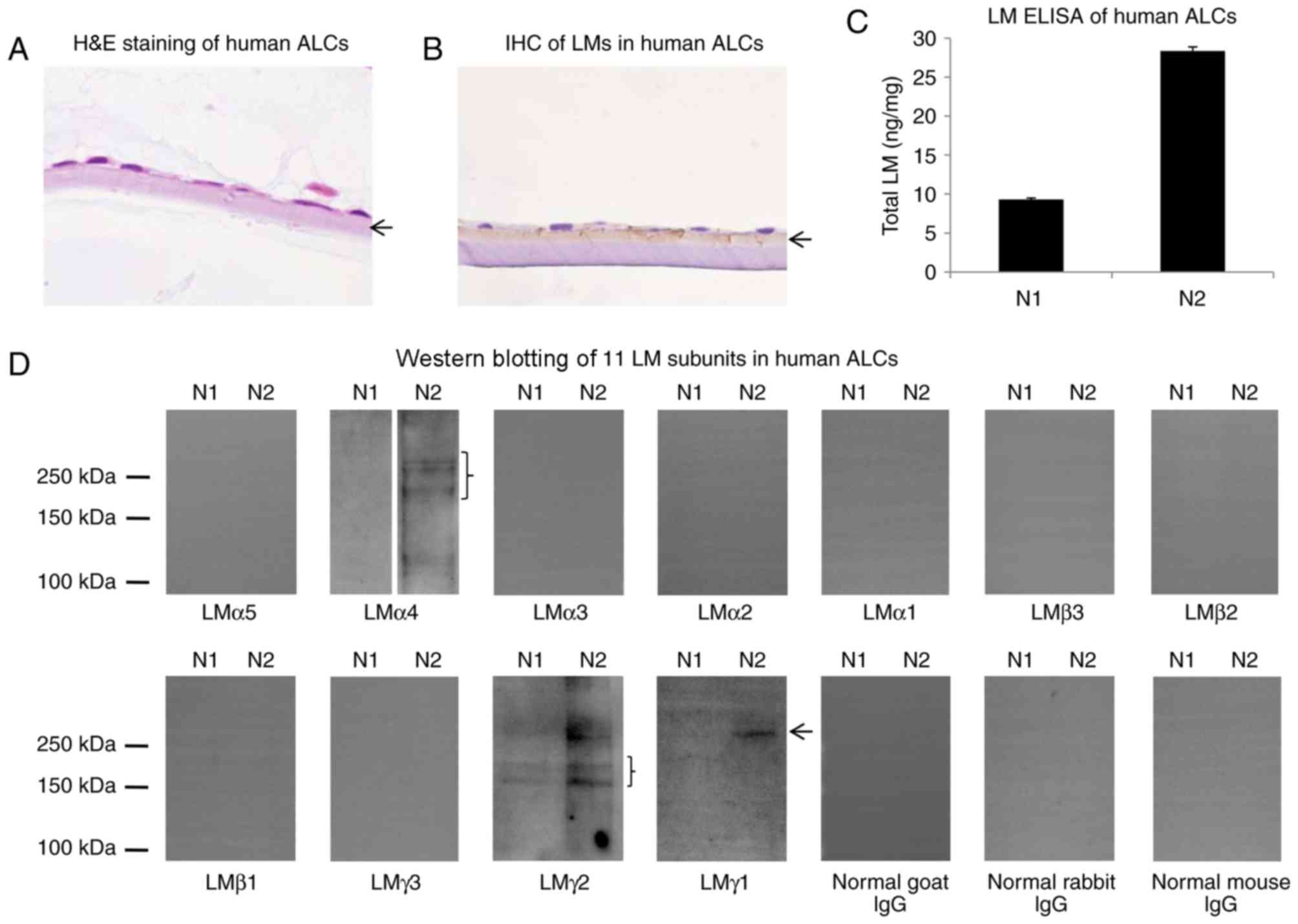|
1
|
Michael R and Bron AJ: The ageing lens and
cataract: A model of normal and pathological ageing. Philos Trans R
Soc Lond B Biol Sci. 366:1278–1292. 2011. View Article : Google Scholar : PubMed/NCBI
|
|
2
|
Bourne RR, Stevens GA, White RA, Smith JL,
Flaxman SR, Price H, Jonas JB, Keeffe J, Leasher J, Naidoo K, et
al: Causes of vision loss worldwide, 1990–2010: A systematic
analysis. Lancet Glob Health. 1:e339–e349. 2013. View Article : Google Scholar : PubMed/NCBI
|
|
3
|
Khairallah M, Kahloun R, Bourne R, Limburg
H, Flaxman SR, Jonas JB, Keeffe J, Leasher J, Naidoo K, Pesudovs K,
et al: Number of people blind or visually impaired by cataract
worldwide and in world regions, 1990 to 2010. Invest Ophthalmol Vis
Sci. 56:6762–6279. 2015. View Article : Google Scholar : PubMed/NCBI
|
|
4
|
Pollreisz A and Schmidt-Erfurth U:
Diabetic cataract-pathogenesis, epidemiology and treatment. J
Ophthalmol. 2010:6087512010. View Article : Google Scholar : PubMed/NCBI
|
|
5
|
Roberts JE: Ultraviolet radiation as a
risk factor for cataract and macular degeneration. Eye Contact
Lens. 37:246–249. 2011. View Article : Google Scholar : PubMed/NCBI
|
|
6
|
Asbell PA, Dualan I, Mindel J, Brocks D,
Ahmad M and Epstein S: Age-related cataract. Lancet. 365:599–609.
2005. View Article : Google Scholar : PubMed/NCBI
|
|
7
|
Rao GN, Khanna R and Payal A: The global
burden of cataract. Curr Opin Ophthalmol. 22:4–9. 2011. View Article : Google Scholar : PubMed/NCBI
|
|
8
|
Bhat SP: The ocular lens epithelium.
Biosci Rep. 21:537–563. 2001. View Article : Google Scholar : PubMed/NCBI
|
|
9
|
Li WC, Kuszak JR, Dunn K, Wang RR, Ma W,
Wang GM, Spector A, Leib M, Cotliar AM, Weiss M, et al: Lens
epithelial cell apoptosis appears to be a common cellular basis for
non-congenital cataract development in humans and animals. J Cell
Biol. 130:169–181. 1995. View Article : Google Scholar : PubMed/NCBI
|
|
10
|
Martinez G and de Iongh RU: The lens
epithelium in ocular health and disease. Int J Biochem Cell Biol.
42:1945–1963. 2010. View Article : Google Scholar : PubMed/NCBI
|
|
11
|
Schéele S, Nyström A, Durbeej M, Talts JF,
Ekblom M and Ekblom P: Laminin isoforms in development and disease.
J Mol Med (Berl). 85:825–836. 2007. View Article : Google Scholar : PubMed/NCBI
|
|
12
|
Durbeej M: Laminins. Cell Tissue Res.
339:259–268. 2010. View Article : Google Scholar : PubMed/NCBI
|
|
13
|
Yurchenco PD and Patton BL: Developmental
and pathogenic mechanisms of basement membrane assembly. Curr Pharm
Des. 15:1277–1294. 2009. View Article : Google Scholar : PubMed/NCBI
|
|
14
|
Miner JH and Yurchenco PD: Laminin
functions in tissue morphogenesis. Annu Res Cell Dev Biol.
20:255–284. 2004. View Article : Google Scholar
|
|
15
|
Byström B, Virtanen I, Rousselle P,
Gullberg D and Pedrosa-Domellöf F: Distribution of laminins in the
developing human eye. Invest Ophthalmol Vis Sci. 47:777–785. 2006.
View Article : Google Scholar : PubMed/NCBI
|
|
16
|
Kohno T, Sorgente N, Ishibashi T,
Goodnight R and Ryan SJ: Immunofluorescent studies of fibronectin
and laminin in the human eye. Invest Ophthalmol Vis Sci.
28:506–514. 1987.PubMed/NCBI
|
|
17
|
Uechi G, Sun Z, Schreiber EM, Halfter W
and Balasubramani M: Proteomic view of basement membranes from
human retinal blood vessels, inner limiting membranes, and lens
capsules. J Proteome Res. Jul 17–2014.(Epub ahead of print).
View Article : Google Scholar : PubMed/NCBI
|
|
18
|
Danysh BP and Duncan MK: The lens capsule.
Exp Eye Res. 88:151–164. 2009. View Article : Google Scholar : PubMed/NCBI
|
|
19
|
Zenker M, Tralau T, Lennert T, Pitz S,
Mark K, Madlon H, Dötsch J, Reis A, Müntefering H and Neumann LM:
Congenital nephrosis, mesangial sclerosis and distinct eye
abnormalities with microcoria: An autosomal recessive syndrome. Am
J Med Genet A. 130A:1–145. 2004. View Article : Google Scholar
|
|
20
|
Stunf S, Hvala A, Vidovič Valentinčič N,
Kraut A and Hawlina M: Ultrastructure of the anterior lens capsule
and epithelium in cataracts associated with uveitis. Ophthalmic
Res. 48:12–21. 2012. View Article : Google Scholar : PubMed/NCBI
|
|
21
|
Suh J, Moncaster JA, Wang L, Hafeez I,
Herz J, Tanzi RE, Goldstein LE and Guénette SY: FE65 and FE65L1
amyloid precursor protein-binding protein compound null mice
display adult-onset cataract and muscle weakness. FASEB J.
29:2628–2639. 2015. View Article : Google Scholar : PubMed/NCBI
|
|
22
|
Joo CK, Lee EH, Kim JC, Kim YH, Lee JH,
Kim JT, Chung KH and Kim J: Degeneration and transdifferentiation
of human lens epithelial cells in nuclear and anterior polar
cataracts. J Cataract Refract Surg. 25:652–658. 1999. View Article : Google Scholar : PubMed/NCBI
|
|
23
|
de Iongh RU, Wederell E, Lovicu FJ and
McAvoy JW: Transforming growth factor-beta-induced
epithelial-mesenchymal transition in the lens: A model for cataract
formation. Cells Tissues Organs. 179:43–55. 2005. View Article : Google Scholar : PubMed/NCBI
|
|
24
|
Arita T, Murata Y, Lin LR, Tsuji T and
Reddy VN: Synthesis of lens capsule in long-term culture of human
lens epithelial cells. Invest Ophthalmol Vis Sci. 34:355–362.
1993.PubMed/NCBI
|
|
25
|
Hirako Y, Yonemoto Y, Yamauchi T,
Nishizawa Y, Kawamoto Y and Owaribe K: Isolation of a
hemidesmosome-rich fraction from a human squamous cell carcinoma
cell line. Exp Cell Res. 324:172–182. 2014. View Article : Google Scholar : PubMed/NCBI
|
|
26
|
Li X, Qian H, Sogame R, Hirako Y, Tsuruta
D, Ishii N, Koga H, Tsuchisaka A, Jin Z, Tsubota K, et al: Integrin
β4 is a major target antigen in pure ocular mucous membrane
pemphigoid. Eur J Dermatol. 26:247–253. 2016.PubMed/NCBI
|
|
27
|
Andjelic S, Drašlar K, Hvala A and Hawlina
M: Anterior lens epithelium in cataract patients with retinitis
pigmentosa-scanning and transmission electron microscopy study.
Acta Ophthalmol. 95:e212–e220. 2017. View Article : Google Scholar : PubMed/NCBI
|
|
28
|
Li X, Qian H, Takizawa M, Koga H,
Tsuchisaka A, Ishii N, Hayakawa T, Ohara K, Sitaru C, Zillikens D,
et al: N-linked glycosylation on laminin γ1 influences recognition
of anti-laminin γ1 pemphigoid autoantibodies. J Dermatol Sci.
77:125–129. 2015. View Article : Google Scholar : PubMed/NCBI
|
|
29
|
Patrick B, Li J, Jeyabal PV, Reddy PM,
Yang Y, Sharma R, Sinha M, Luxon B, Zimniak P, Awasthi S, et al:
Depletion of 4-hydroxynonenal in hGSTA4-transfected HLE B-3 cells
results in profound changes in gene expression. Biochem Biophys Res
Commun. 334:425–432. 2005. View Article : Google Scholar : PubMed/NCBI
|
|
30
|
Sigle RO, Gil SG, Bhattacharya M, Ryan MC,
Yang TM, Brown TA, Boutaud A, Miyashita Y, Olerud J and Carter WG:
Globular domains 4/5 of the laminin alpha3 chain mediate deposition
of precursor laminin 5. J Cell Sci. 117:4481–4494. 2004. View Article : Google Scholar : PubMed/NCBI
|
|
31
|
Frank DE and Carter WG: Laminin 5
deposition regulates keratinocyte polarization and persistent
migration. J Cell Sci. 117:1351–1363. 2004. View Article : Google Scholar : PubMed/NCBI
|
|
32
|
Zhang XH, Sun HM and Yuan JQ:
Extracellular matrix production of lens epithelial cells. J
Cataract Refract Surg. 27:1303–1309. 2001. View Article : Google Scholar : PubMed/NCBI
|
|
33
|
Gonzalez AM, Gonzales M, Herron GS,
Nagavarapu U, Hopkinson SB, Tsuruta D and Jones JC: Complex
interactions between the laminin alpha 4 subunit and integrins
regulate endothelial cell behavior in vitro and angiogenesis in
vivo. Proc Natl Acad Sci USA. 99:pp. 16075–16080. 2002; View Article : Google Scholar : PubMed/NCBI
|
|
34
|
Patarroyo M, Tryggvason K and Virtanen I:
Laminin isoforms in tumor invasion, angiogenesis and metastasis.
Semin Cancer Biol. 12:197–207. 2002. View Article : Google Scholar : PubMed/NCBI
|
|
35
|
Qu H, Liu X, Ni Y, Jiang Y, Feng X, Xiao
J, Guo Y, Kong D, Li A, Li X, et al: Laminin 411 acts as a potent
inducer of umbilical cord mesenchymal stem cell differentiation
into insulin-producing cells. J Transl Med. 12:1352014. View Article : Google Scholar : PubMed/NCBI
|













